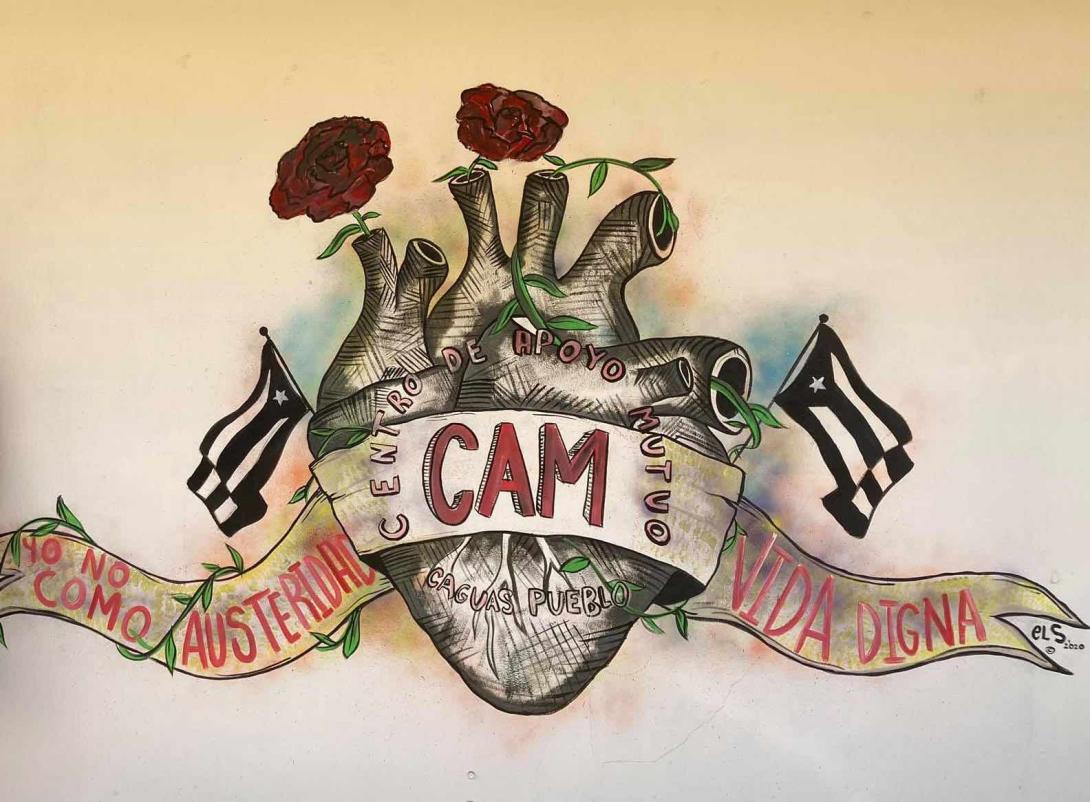
Puerto Rico's Road to Decolonization
cross-posted from CrimethInc.
Throughout the tumultuous year of 2020, people in many parts of the world were jolted into rediscovering the importance of relying on one another. The people of Puerto Rico, however, have long understood the power of mutual aid as a means of both survival and resistance. After Hurricane Maria devastated the island in September 2017—inflicting nearly 3000 deaths, robbing thousands of shelter, and leaving millions without electricity, tap water, and phone service—Puerto Ricans self-organized at the grassroots level to meet each other’s immediate needs in view of the grossly inadequate responses of both local and federal government.

The Centros de Apoyo Mutuo
Existing activist groups occupied vacant buildings across the island, transforming them into hubs for relief and rebuilding efforts. Today, these Centros de Apoyo Mutuo (mutual aid centers, or CAMs) comprise a network of community organizations, sustained by donations and solidarity efforts from both local community members and Puerto Ricans in the diaspora. While each community has its own unique needs and goals, the CAMs share a common purpose that has evolved from providing for basic survival needs to building resilience in the midst of a decade-long economic depression and crises such as the earthquake of January 2020. These bold, optimistic efforts feed into a larger, more comprehensive purpose—moving toward autonomy on an archipelago that has endured over 500 years of colonialism and currently remains a colony of the United States.
Before Hurricane Maria made landfall on the main island on September 20, 2017, two weeks after Hurricane Irma had caused significant damage to the offshore islands, a number of man-made factors had converged to leave Puerto Rico vulnerable to the humanitarian crisis that followed this natural disaster. In 2006, the US government eliminated the federal tax subsidies that had attracted mainland corporations to the island. The subsequent departure of these companies resulted in massive job loss that plunged almost half the population into poverty, triggering a steady economic decline over the next ten years. The Puerto Rican government attempted to compensate for the loss of tax revenue by borrowing from banks and bond brokers on Wall Street, accruing $72 billion in bond debt and essentially bankrupting the government.
In response to the fiscal crisis, in 2016, President Obama enacted legislation establishing the Financial Oversight and Management Board: seven Washington-appointed lawyers and financial advisers who have ultimate control over the island’s budget and finances. Among the people of Puerto Rico, the FOMB is referred to as la junta, a term that usually connotes a military dictatorship.
“We use that term because we are actually living in a dictatorship,” explains Daniel Orsini, one of the coordinators of the Puerto Rico Mutual Aid regional network (PRAM) and an organizer of the CAM in Las Carolinas. “We, as part of Latin America, adopted that term because it’s a civil junta. They are dictating the terms of our fiscal policy—how much money goes to the university, how much goes to public healthcare, how much goes to communities. That civil dictatorship is imposing more austerity on our people.” He believes the junta exists to legitimize the Puerto Rican government’s debt to Wall Street, which is not legally binding under international law. Daniel also believes, while the junta originally included several financiers from Puerto Rico, “They don’t see themselves as Puerto Rican. They are very racist against even themselves. That’s part of the colonialist ideology.”
The oversight board, which currently consists entirely of US-born appointees, has instituted a rash of widely-protested austerity measures in the name of resolving the debt crisis, including budget cuts to the archipelago’s state-owned electric utility company. The Puerto Rico Electric Power Authority (PREPA) was a major culprit in the government’s excessive borrowing, accumulating $9 billion in bond debt. By the time Hurricane Maria hit, years of corruption, mismanagement, and lack of investment at PREPA had left the infrastructure antiquated and feeble. It was completely decimated by the storm.
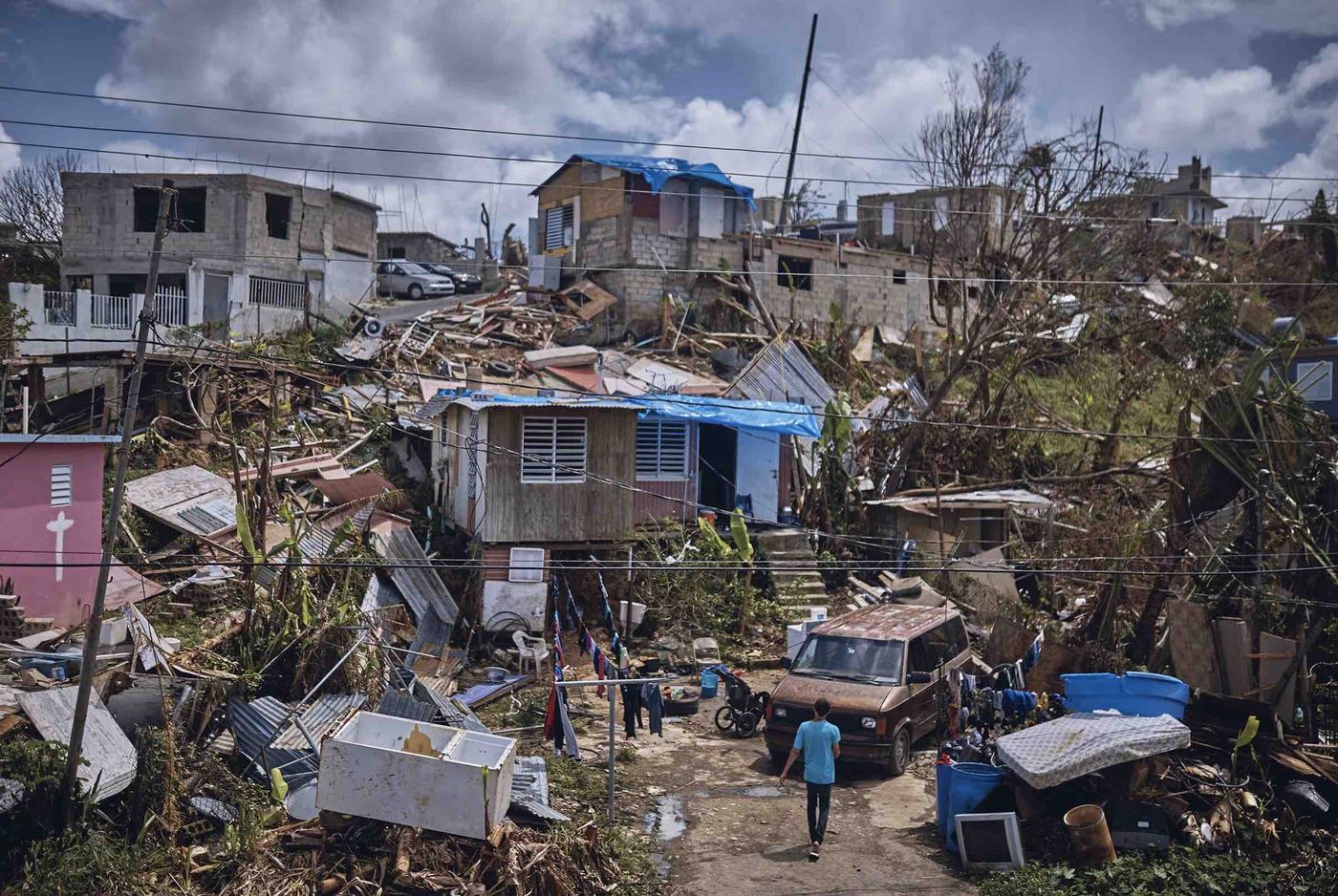
While the number of people killed directly by the hurricane was set at 64 in the weeks that followed, a study conducted by George Washington University in 2018 estimated that fully 2975 people in Puerto Rico lost their lives as a result of Maria, taking into account those who died over the following six months due to lack of access to healthcare, electricity, and clean water. A 2018 research paper from Harvard estimated the number of deaths over the four months following Maria at 4645, a figure that was utilized as a powerful symbol in the island’s anti-government uprising of 2019. The hurricane damaged hundreds of thousands of homes, completely destroying about 70,000 of them. Families who didn’t lose their homes entirely have had to live with blue tarps in place of the roofs that were ripped away by the storm. Today, tens of thousands of roofs still have not been replaced. The unlivable conditions created by property and infrastructure damage, as well as its impact on the local economy, triggered a population crash in which 130,000 residents migrated to the US mainland over the next year.
During the hurricane, 150-mile-per-hour winds and flooding wrecked Puerto Rico’s power grid, leaving the entire island without electricity. More than half the population had no tap water and 95% of cell networks were down, as were most phone and internet cables. A month later, a third of the hospitals were still operating on generators. It took almost a year to fully restore electrical service. Cut off from repair crews due to delays in repairing highways and bridges, people in rural areas were the last to receive help.
Rather than requesting assistance in repairing the grid from other state-owned utilities on the mainland, as PREPA was eligible to do in emergencies, the company awarded a no-bid $300 million contract to Whitefish Energy, an inexperienced Montana company that, having only two employees itself, subcontracted those same public utility crews at twice the cost to taxpayers. The contract raised suspicions of cronyism, as US Interior Secretary Ryan Zinke was a personal acquaintance of Whitefish’s CEO; in addition, the company was backed by HBC Investments, whose founder was a major donor to Donald Trump.
Following investigations by DHS and the FBI, Puerto Rico’s then Governor Ricardo Rosselló canceled the contract. Yet most Puerto Ricans still remained without power in their homes. Eight months after Maria’s landfall, the Federal Emergency Management Agency refused to extend its contract to repair the grid and pulled the mainland work crews it had hired through the US Army Corps of Engineers from the island, leaving PREPA to complete repairs for about 16,000 homes. Even after all PREPA customers were finally able to turn their lights back on, the structural issues that predated the storm remained, returning Puerto Ricans to a status quo in which 98% of their energy came fossil fuel-based sources, causing rampant pollution, and in which they paid 80 to 100% higher prices than people in the mainland US for electrical service that was already subject to regular power outages.
With no access to clean drinking water, residents were forced to obtain water from potentially contaminated sources including nearby streams. Three months after the storm, water systems had been restored for less than 60% of the island, and floodwater had contaminated much of the available tap water with sewage and other toxins, leaving some residents so desperate for drinking water that they resorted to tapping wells at hazardous waste sites. As with the electrical grid, the hurricane only exacerbated structural weaknesses that had previously existed in Puerto Rico’s water infrastructure. A combination of inherent flaws in the island’s aquifers—allowing contaminants to pollute groundwater—and leaks caused by lack of investment in pumping stations and treatment plants resulted in almost 70% of the population getting their water from systems in violation of federal health standards. This has been linked to reports of gastrointestinal diseases and other serious health problems across the island.
An internal report by FEMA released in 2018 acknowledged that the agency was unprepared to respond to Hurricane Maria in Puerto Rico in that they lacked supplies to distribute, including generators; that the agency failed to properly track supplies in their delivery from the mainland; and that its preparations didn’t take into account the infrastructure issues that would obstruct distribution on the island, such as the power outages, the need for satellite phones in the absence of cell and internet service, and the obstacles to transportation. There have since been multiple incidents of stockpiles of undistributed relief items being discovered in Puerto Rico, including tens of thousands of expired FEMA water bottles found abandoned on an unused runway in September 2018 and a warehouse full of emergency supplies found in the city of Ponce just after the earthquake in January 2020. There is a video of people breaking into the warehouse and distributing items to those impacted by that disaster.
With so many having died as a result of lacking access to essential items and resources, revelations like these have sparked widespread anger and fueled action from Puerto Ricans on the island and in the diaspora. “Hurricane Maria was not a natural crisis, it was a political crisis,” says Pluma Barbara Moreno, a coordinator of Centro de Apoyo Mutuo Jíbaro (CAM-JI) in Lares.
While the storm’s immediate aftermath saw US politicians and corporate media corroborate the narrative that Puerto Rico and its citizens were part of the US, the federal government’s response to Maria revealed the true nature of its relationship with the archipelago and its people. One glaring example of this is Trump’s initial refusal to waive the Jones Act, a 1920 shipping regulation that, in addition to impeding the delivery of desperately-needed food and relief items to the island after Maria, has also crippled the Puerto Rican economy and driven up the cost of living there for decades. By requiring that goods shipped between US ports be carried by American-built ships, crewed by US citizens, the law makes it unnecessarily expensive to transport goods from the mainland; it has often been waived when an emergency makes it necessary to speed the shipment of supplies to parts of the US. In fact, Trump had issued waivers earlier that month to areas affected by Hurricane Harvey, but in this case the administration deferred to pressure from the US shipping industry and didn’t lift the restrictions until, faced with heavy criticism for its slow response in Puerto Rico, the White House announced that it would waive the law for ten days.
Disaster capitalists saw the chaos created by Maria as an opportunity to profit on the privatization of Puerto Rico’s public services. In January 2018, the governor announced plans to privatize PREPA, a measure that the junta had urged for quite some time. Rosselló signed a law in June of that year to allow the utility company to be sold piecemeal to private entities, a process that continues to this day. Another public service the FOMB had long aimed to privatize was the public school system. Julia Keleher, who had been Puerto Rico’s Secretary of Education since the beginning of 2017 and has since been indicted on multiple federal charges of fraud, claimed she saw the devastation from the storm as an opportunity to “press the reset button” on the public school system. In March 2018, Rosselló signed into law a comprehensive “educational reform” package that included closing 179 schools and opening charter schools, as well as introducing private school vouchers—a plan that echoed the privatization of the New Orleans school system after Hurricane Katrina. The Puerto Rico Department of Education had already shuttered hundreds of schools as part of the junta’s austerity regime before Keleher, who is not Puerto Rican and whose background is as a private education consultant in Washington, was appointed head of the department.
A common Puerto Rican expression was often repeated during this time: Solo el pueblo salva al pueblo (“Only the people save the people”). Grief-stricken by the mounting death toll and faced with the incompetence and indifference of the state, people in both the archipelago and the diaspora had no choice but to save each other. Existing grassroots groups sprang into action, coordinating efforts to distribute the resources necessary to keep people alive in the short term. “The prerogative of healing the trauma from colonization is with the people, in their own communities,” says Lourdes Hernández, who coordinates PRAM along with Daniel and is also a coordinator of CAM Carolinas.
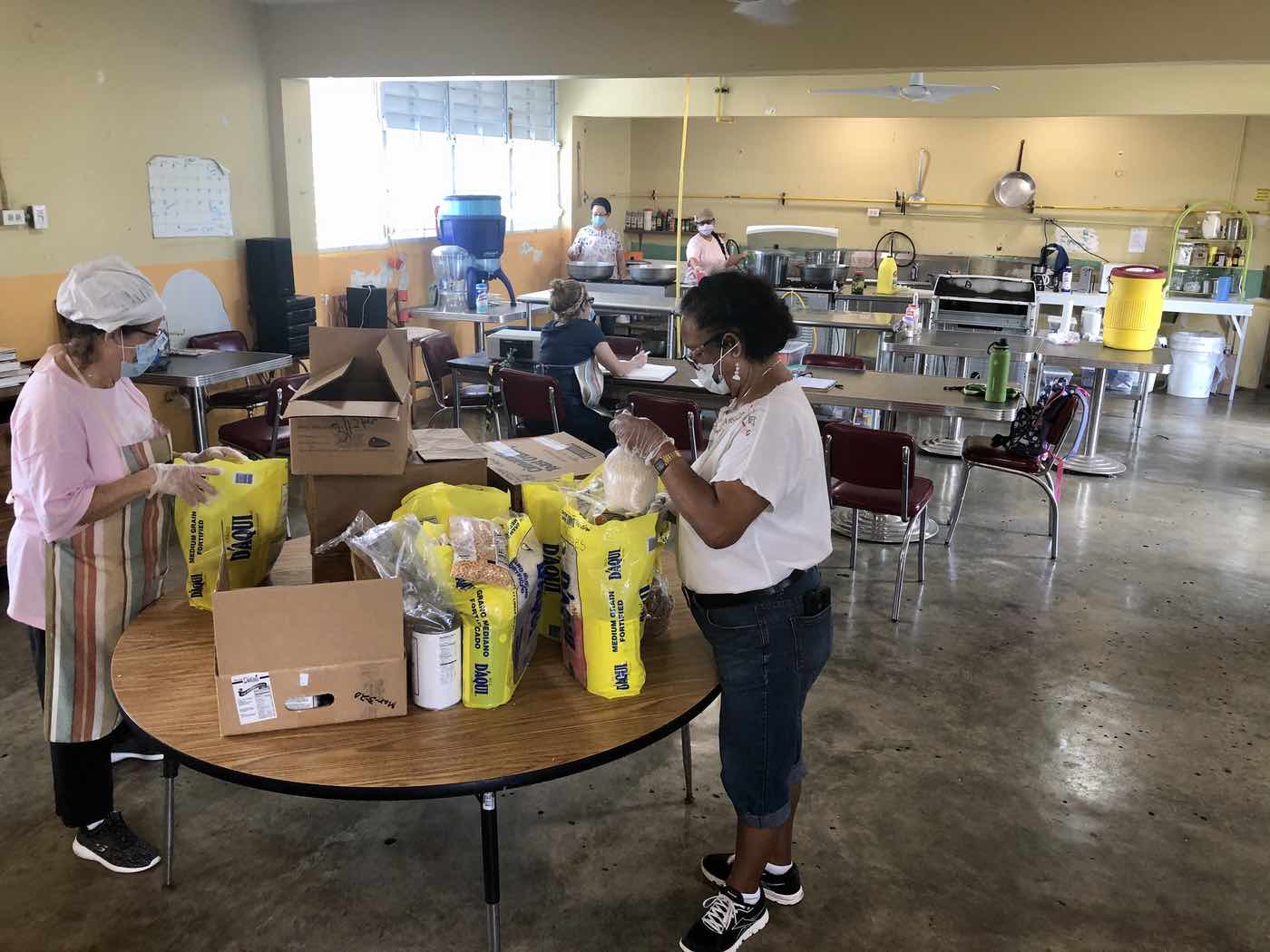
Lourdes and Daniel had been part of the Center for Political, Educational, and Cultural Development, a grassroots organization formed in 2012 by students and alumni of the University of Puerto Rico as a response to the injustices exacerbated by the austerity program. The group started its first social project, called Comedor Social (“Social Dining Room”), at the UPR campus in Cayey to distribute food in solidarity with hungry students and workers, and in protest of the cafeteria’s high prices. Inspired by this initiative, students at several other UPR campuses started community kitchens to cook and share food with their fellow students, all sustained by donations and volunteer labor. The Comedor Social at the main campus in Río Piedras proved invaluable to the students who participated in the student strike there for 72 days in the spring of 2017. Beginning with UPRRP, students at all 11 campuses barricaded themselves within the campus gates and set up resistance camps to protest a $450 million budget cut to the university proposed by the junta, as well as a threatened tuition increase.
Their work on that project prepared Lourdes and Daniel to self-organize on a larger scale after Maria struck. Also, Daniel explains, because the lack of phone and internet service in the following weeks made it impossible to communicate over long distances, their proximity in Caguas to the comrades with whom they’d worked at UPR put them in an advantageous position to be able to coordinate with them. He recalls how they all traveled back and forth between Caguas and Río Piedras during that period, leaving notes under each other’s doors in order to meet and discuss the mutual aid initiative they would establish in their community.
Six days after Hurricane Maria, they set up a community kitchen in the center of the municipality of Caguas, serving breakfast to 150 people and lunch to 300. This initiative became the first of the Centros de Apoyo Mutuo. After the CAM had been operating for about a month, they invited comrades from all over the island to visit and proposed that this be the new direction for Puerto Rico’s radical movements. CAM Caguas became the model people used as they built new CAMs throughout the island, with each community adapting the model to its own particular needs. As CAM Caguas is housed in an abandoned school that the comrades occupied and repurposed to meet the needs of the community in this moment of crisis, other CAMs have followed the model of occupying vacant public buildings and spaces. Hurricane Maria hit on the heels of a summer during which Keleher had closed 183 active schools, leaving them empty and unused. People seized the opportunity to take back some of those schools for the community.
A group of women who had participated in CAM Caguas observed firsthand the building occupations that group organized, and were inspired to start a mutual aid center in Las Carolinas, a neighborhood in Caguas. “When they realized that they could also take over a building—the school in their own community that had been abandoned—they called us,” recalls Lourdes. It has now been three years since these women opened the gate to CAM Carolinas. At first, Lourdes explains, the comrades at CAM Caguas supported their community kitchen by sharing food donations; after a month, they also began to contribute relaxation therapy services for their wellness center, including auricular acupuncture. After two months, the new CAM started to collect donations and opened a free store. By August 2018, they had started an art therapy program for elderly people as well, in a community where the majority of the population of 3000 are over 65 years old. Ninety-five percent of the volunteers at CAM Carolinas are women between 35 and 80 years old, though since the beginning of the COVID-19 pandemic, they have added over 20 more volunteers between 16 and 30 years old, most of whom are male-identifying.
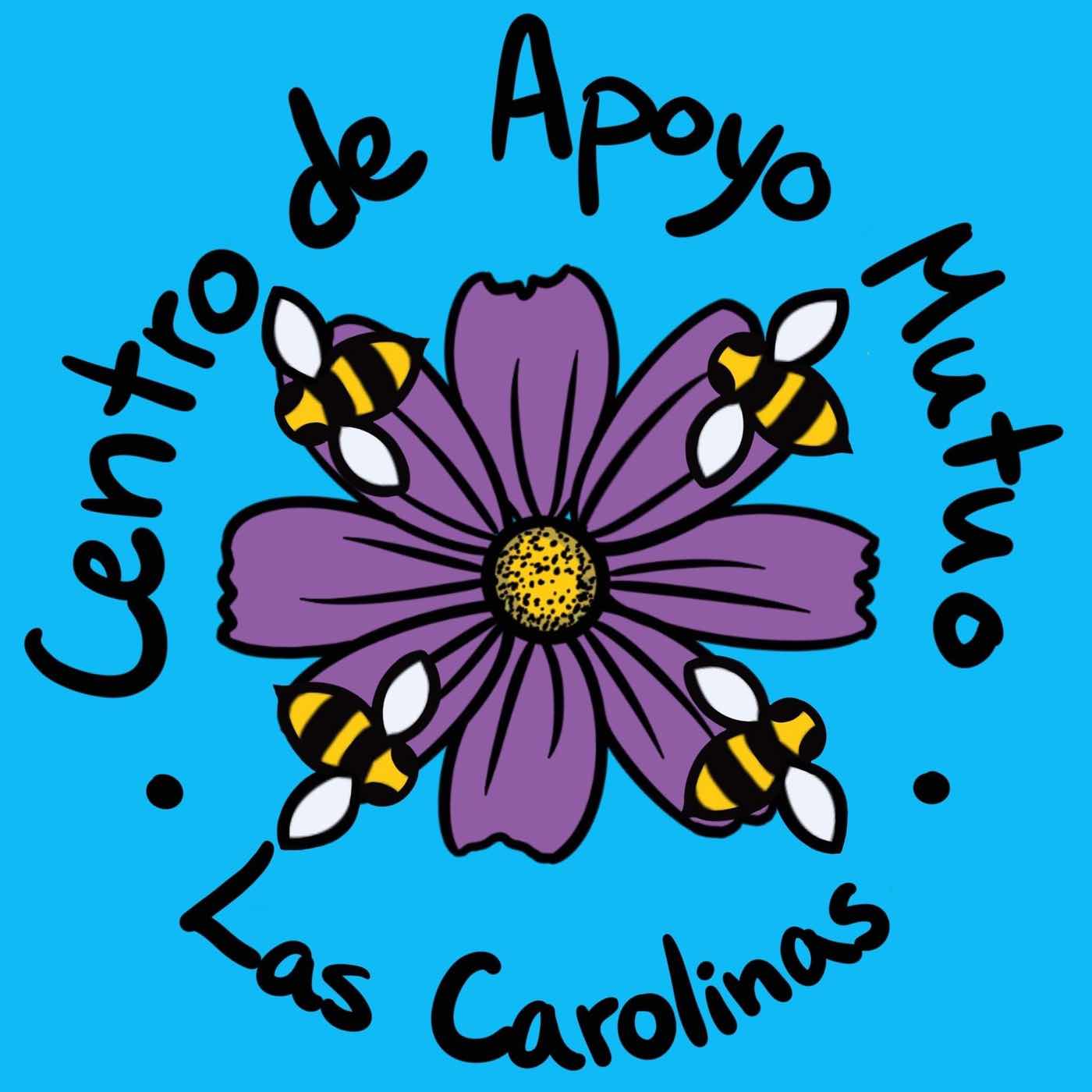
Another project modeled on CAM Caguas is CAM Jíbaro, comprised of three centers, two of which are in Lares, a rural village in the central mountains. One of these is located in the neighborhood of Bartolo, where local residents renovated an abandoned school the month after Maria to provide shelter for unhoused families. CAM-JI Bartolo currently houses six families in temporary apartments and serves as a community kitchen. The other of these initiatives is organized by the Center for Transdisciplinary Studies in Agroecology (CETA), a collective that advocates for traditional farming practices, of which Pluma is a co-founder. CAM-JI CETA aims to build food sovereignty for the region using the agricultural methods of the Jíbaro, an Indigenous group and a culture of peasant farmers with its roots in the center of the island.
A trained sociologist and Indigenous activist, Pluma is a forerunner in the fight for Jíbaro farmers’ right to use their land for the cultivation of food and medicine. In the wake of Maria, which wiped out 80% of the island’s agricultural crop, she says it was clear that CETA needed to change its structure to respond to the crisis. For two years, they have organized brigades, workshops, and other events to promote agroecology, the production of food without negative impacts on the environment—prioritizing soil remediation, diversification, and pest control without the use of chemicals. In collaboration with other grassroots organizations involving a broad range of age groups, including UPR students, they incubate cooperative farming projects to be self-directed by communities who want to meet their own food, medicinal, and economic needs through jíbara agriculture. The CAM represents one of many initiatives in Puerto Rico’s popular agro-ecology movement, which in recent years has cultivated what Pluma refers to as a “vindication of traditional practices.”
The underlying issue for jíbara farmers, Pluma emphasizes, is that they don’t own the land. Though the state refuses to recognize any Indigenous peoples in Puerto Rico, these communities continue to advocate for recognition of their ancestral rights in diverse and creative ways. History books teach that people indigenous to the island—called Borikén by the Taíno people who originally inhabited the islands of the Caribbean, and today by people of First Nation heritage—were exterminated in the late 15th century after Christopher Columbus’s arrival and the ensuing Spanish colonization. Archaeological evidence of these peoples’ survival, as well as a biological study showing the Indigenous ancestry of modern Puerto Ricans, contradicts this. Today, Taíno and Jíbaro groups persist in resisting colonialism by countering the narrative of their extinction and fighting for the return of the land that belonged to their ancestors.

The school CAM-JI CETA has occupied for about ten months is inside a public housing project, and it was the project’s residents who told the group they should take over the shuttered building because it belonged to the community. Right now, people of all ages who used to study at the school are helping to reconstruct it. The coordinators work closely with the community to learn what they want and to create the services that will be most useful. Everyone, including the children of the community, has been involved in making decisions about what services the center will provide. Pluma says the kids have suggested a gym with a basketball court, martial arts classes, and workshops offering skills such as fishing and agriculture. The CAM’s many collaborations include people who work in the arts and theater, organizations that focus on psychological and emotional issues, and lawyers who want to provide the community with legal aid.
CAMs have also served as hubs for their communities’ energy and water needs by partnering with other mutual aid initiatives to install modular systems in the centers. Mutual Aid Disaster Relief, a solidarity-based grassroots network that has supported community-led relief and rebuilding efforts in areas impacted by disasters since Hurricane Katrina, visited Puerto Rico in pods of volunteers immediately after Maria to support the autonomous relief efforts that had already begun in local communities. Rain, an organizer with MADR whose background is in environmental engineering, recalls how they brought a modular water filtration system on their first trip as an alternative to the smaller water filters that were being donated at the time, which Rain says were not as apt to remove all the bacteria caused by factors such as dead animals in the streams people were relying on. They transported the modular system around the island in two large suitcases, treating water in areas that were hard to reach, such as mountainous regions. As long as there was a water source nearby, Rain explains, they could treat it by feeding the hose into the river or stream and pumping water through the system with the hand pump, at the end of which it was chlorinated in a plastic tub. The modular filtration system is currently stored by a local organizer in San Juan, whom the other members of the CAM network contact whenever they need it.
As the CAMs emerged as distribution centers and locations where community members went to support each other, MADR was able to partner with organizers in places like Caguas and Lares who had similar ideas about the centers serving as energy hubs. Together, they began to install solar panel systems donated by MADR’s community partners. Improving on the rapid response system in which people collected filtered water in jugs at the sources, organizers eventually set up cisterns and rain barrels for water storage at the CAMs, which had become spots for people to do laundry and to get internet and phone reception.
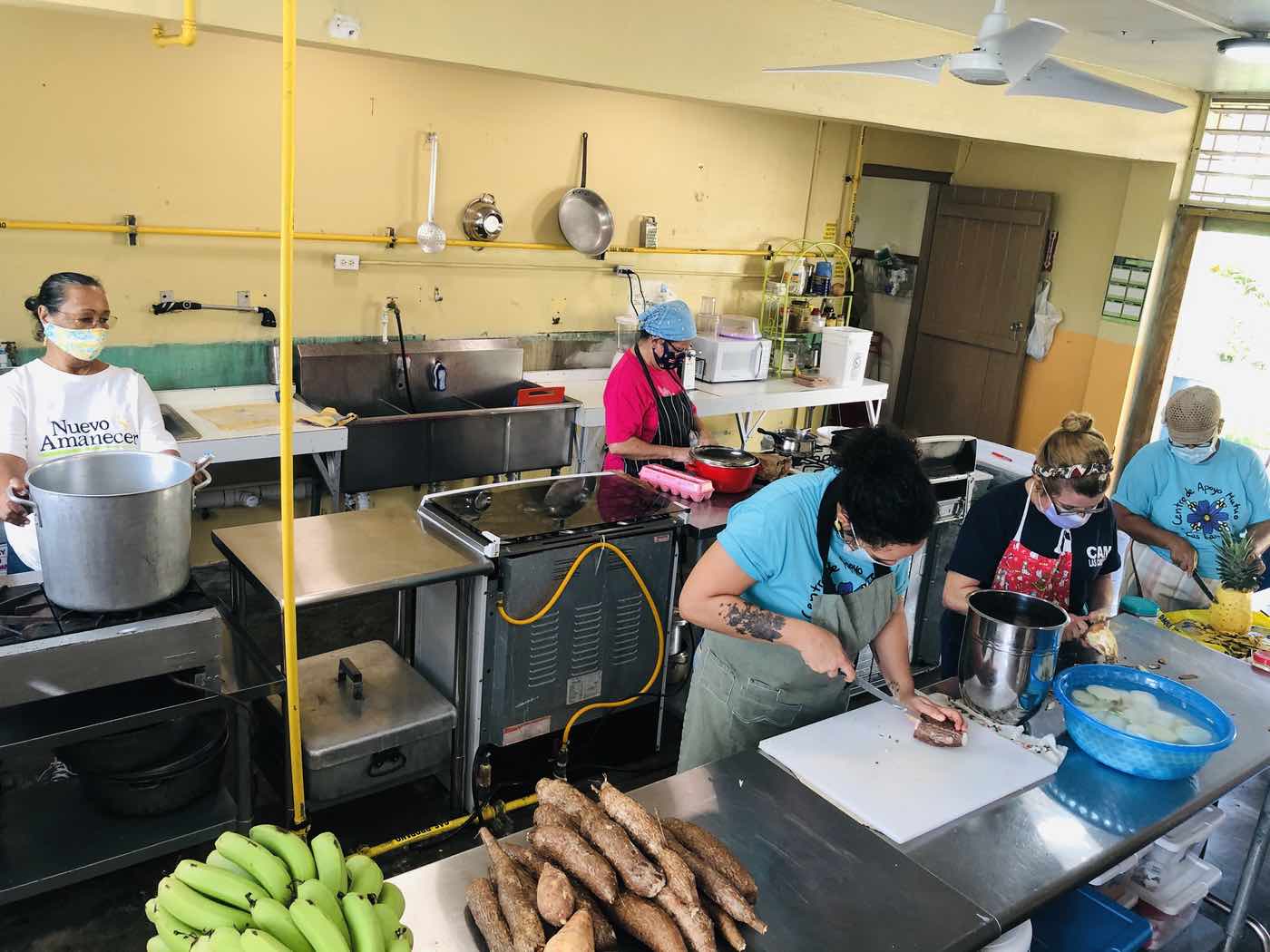
The Revolt of 2019
What Pluma refers to as the political crisis of Hurricane Maria didn’t just unite the people of Puerto Rico in solidarity with one another; it also collided with decades of growing frustration with their colonial government, igniting a chain of successive political crises and popular revolt. Raul Maldonado, who at the time was Puerto Rico’s Treasury Secretary, was forced to resign in June 2019 after making comments to a local radio station alleging rampant corruption within Rosselló’s administration. In early July, blogger Sandra Rodríguez Cotto released app messages from a private chat between Rosselló and eleven close associates, leaked by an anonymous source, in which the men shared misogynistic, homophobic, and racist comments. On July 10, several senior officials and contractors in Rosselló’s administration, including Keleher, were arrested by the FBI on charges involving the misappropriation of federal funds. Several days later, the Puerto Rico Center for Investigative Journalism, an independent news site, published 889 pages of the leaked texts, revealing a multi-billion dollar network of corruption in which the governor’s cronies in the private sector influenced contracts and directed the use of public funds for their own financial benefit. The chat messages also showed the governor and others in the group, which included several of his cabinet members and advisors, discussing using government funds to influence the press and employ social media trolls, and making callous jokes about the deaths caused by Hurricane Maria.
The rage that these revelations sparked catalyzed two weeks of sustained mobilization in which hundreds of thousands marched through the streets, demanding Rosselló’s resignation. When the governor landed at the airport in San Juan on July 11, having cut short his vacation in Paris after the texts were leaked, he was met by nearly 100 protesters gathered by the Colectiva Feminista en Construcción, a group of women who’d recently lead demonstrations to demand Rosselló take action on gender-based violence in Puerto Rico. The mass protests that followed, outside the governor’s mansion in San Juan and in municipalities all over the archipelago, were the culmination of years of autonomous organizing in response to the economic crisis, the draconian austerity measures imposed by the junta, the federal and local government’s incompetent recovery process after Maria, and the inherent oppression and violence of US colonialism, which was what made Puerto Rico dependent on a government controlled by corporate interests in the first place. Rosselló, the 40-year-old son of a former governor who’d grown up among the island’s elite and been elected to its top office with almost no political experience, had become a symbol of all of those injustices.
NOW: Authorities have moved in on protestors outside La Fortaleza. #RickyRenuncia @vicenews pic.twitter.com/ZSGp5SFdWu
— aniucar (@AniUcar) July 23, 2019
On July 21, he doubled down on his initial refusal to resign, while conceding that he would step down as president of the New Progressive Party and wouldn’t seek reelection in 2020. The next day, a general strike took place across the island, demanding that the governor resign or be impeached. More than 500,000 people participated in what became known as the March of the People, shutting down the main highway into San Juan, carrying signs displaying the number 4645 to signify the Hurricane Maria death toll determined by the Harvard study, and marching to the governor’s mansion, where the San Juan police fired tear gas on the assembled crowd that night. Protesters were not deterred, however, and demonstrations continued outside Rosselló’s palatial residence. Finally, after much of his cabinet and senior staff had resigned, and in response to other leaders of his political party urging him to leave office, Rosselló announced his resignation on Facebook Live near midnight on July 24, causing the massive crowd outside to burst into cheers, song, and dance. While the Trump administration and some members of Congress seized upon the corruption scandal to justify restricting monetary aid for hurricane recovery and to advance their agenda of privatization, the people of Puerto Rico were developing a different narrative for their political future. With the local government’s legitimacy irreparably damaged, and the colonial nature of the archipelago’s relationship with the US laid bare, it was clear to all that the mobilization must not end with the ousting of one corrupt governor. The questions remained: what new political structure did people want to see? What steps would get them there?
The demonstrators in Puerto Rico who forced the departure of Governor Ricardo A. Rosselló showed how you force a political figure out of power. You don't wait for an FBI investigation or for the next elections. You create a crisis through direct action. May everyone take note. https://t.co/kDwmZzEvDR — CrimethInc. (@crimethinc) July 25, 2019
Facing the Future
“In the case of the CAMs, our work is an important tool on the path towards liberation,” says Lourdes. “The CAMs are offering services and providing basic necessities that the state is not providing, and constantly educating people on how to self-organize. We understand that self-organization is a parallel avenue toward decolonization, so that people who participate in this kind of work can have experiences of surviving without depending the state that they can draw on, and alliances with each other.”
Recently, CAM-JI and CAM Carolinas have joined with two other mutual aid initiatives to form the regional network known as PRAM, of which Lourdes and Daniel are the coordinators, with the goal of supporting and sustaining each other’s work. PRAM also includes Centro de Apoyo Mutuo Bucarabones Unido, located in the Bucarabones neighborhood in the municipality of Las Marías, which operates a community kitchen and a cinema and provides recreational activities for elder adults and educational programs for young people, including art workshops and a community audiovisual production project. The fourth initiative within the network is the Brigada Solidaria del Oeste (“Western Solidarity Brigade”), a group of people from western Puerto Rico and the diaspora. Formed immediately after Hurricane Maria to support communities by cleaning up debris and distributing essential items, the group has continued its mission of solidarity by providing supplies and logistical support to political organizing meetings and to communities impacted by the 2020 earthquakes. Currently, there are fourteen projects across the island involved in a larger network of mutual support, including CAM Caguas and the community kitchen in Río Piedras.
In addition to building resilience to face present and future crises, the network is focused on establishing structures to counteract the ways that colonialism makes its subjects dependent on the colonizer. Toward this end, Pluma and the volunteers at CAM-JI continue to support the development of agro-ecological projects to create food sovereignty in Puerto Rico. Even before Maria destroyed most of its agricultural crop, Puerto Rico imported the vast majority of its food. Pluma believes the solution lies in a return to the traditional methods of farming originally used by the island’s Indigenous people. “On a colonized island,” she says, “the only way to survive is to continue the traditional ways.”

“In Puerto Rico, we basically import more than 80% of what we eat,” says Daniel. “Projects like CAM-JI are crucial in terms of the independence of this island—in terms of food sovereignty, but also our political independence. We want to build power structures for the working class, so that eventually we can challenge the dominant class.” The very root of this problem for Indigenous people, Pluma explains, is that they don’t own the land. For now, CETA continues to work with legal aid and farmers’ groups to implement agrarian reform, both through direct action and by challenging the state to recognize their rights.
“In Lares, we have a big problem of displacement,” says Pluma. “We’re going to deal with that, and we’re going to solve that.” The community in Lares consists mostly of elder people and children, but not many youth. Because there is no economic or social development there, most young people have had to leave the area to find work. Pluma, who was born and raised in Lares, was herself displaced from the region at one time because there were no jobs there. For years, she moved back and forth between San Juan, where her paid work was based, and Lares, where she did agricultural projects to help her community. Now, she’s returned and has been back for three years. “Many of us that have been forced to leave our region to get work in the city or outside the island are coming back.” At the moment, she says, she has four colleagues in the process of moving back to Lares because they want to do their projects in the place where they were born and raised, and they continue to work to bring more comrades back to the region.
Another way Puerto Rican communities are rebuilding to create more autonomy, rather than returning to the status quo, is by establishing alternatives to the broken energy and water infrastructures that were already failing them before Maria. CAM Carolinas installed a solar panel system with the support of MADR about a year ago, which Lourdes says has worked out perfectly; other centers are engaged in conversations with their communities about serving as hubs for community-owned energy and water systems. “Creating a microgrid system in a community that’s going to provide all of the power for everyone is totally possible,” says Rain. “However, it also requires that community to be tight enough to have those conversations about how that energy will be distributed equitably, and how they’re all going to pay into the system in order to have ownership of it collaboratively and collectively.”
Some of the CAMs also continue to maintain their water storage tanks as rainwater catchment systems. Rain believes that, as with energy, water systems work best on the small scale, as opposed to the larger systems on which most cities operate. “Modular systems,” says Rain, “are the best way to conserve the resource, and to make sure people have an understanding of how the energy or the water gets to them so that they conserve in a way that they understand limitations.” If one has a rainwater catchment system, Rain explains, one stays mindful of how much water is available and knows to conserve it. It’s also important that everyone knows how the system works so they can maintain it together. With the solar panel systems, the organizers with MADR didn’t simply install them—the communities helped set them up and learned all they needed to know to maintain them in the process.
“When a disaster happens, you have a vacuum on multiple levels—knowledge, power, etc. If you can come in with different information and just provide it, and show a different example, you can present an alternative world.” Most people, Rain believes, don’t have time to imagine that and work toward it right now because they’re too busy trying to survive the day-to-day. “When you have a collective of people that are willing to work hard together in their own community to imagine something different, and when other folks can come in and support that imagination and help them rebuild it, that takes the labor and the weight of that endeavor off of the community that’s already suffering from the disaster, and then they can get to that goal a little faster. They can see some sort of reward for that work sooner, so that they don’t get that burnout as fast. So if you can fill that void with imagination and with solidarity from the beginning, then you have the opportunity to shift the narrative, and shift the structure of how we, as a community of humans on this planet, are operating.”
As CAM Carolinas continues to provide its original programs (community kitchen, free store, and art therapy), the organizers plan to take a census of the community to learn what other services they can provide that would be useful. “There are still twelve empty rooms in the school that could be used,” she says. The ideas they currently envision for the years to come include an artisanal bakery, midwife services, a room for fermenting food, another room for art therapy for children of all genders, a space for dance, and a room for civic services—providing help with filling out government forms for people who don’t know how to read or write or are not computer literate. “These are just a few possibilities, because we want to keep speaking with the community and coming to understand what they want and what kind of services would be useful to them.”
As they forge ahead with this work, the CAMs remain mindful of the need to stay independent. “This has all been done through unpaid volunteer work, and we’ve never received any kind of government funds,” says Lourdes. “Everything has been either volunteer labor or individual donations from people who care about the project.” Most monetary and in-kind donations the projects receive from outside the island come from Puerto Ricans in the diaspora. Forming this regional network is also a key step toward the CAMs sustaining themselves. “The idea of uniting the CAM in Carolinas with three other CAMs is to join forces to be better able to get donations and the monetary resources that are needed for the project. We’re also considering options like a membership plan or people adopting certain rooms, but the bottom line is to make sure to stay independent of government funds.”
“The strategy behind all these CAMs is to gain independence,” says Daniel. “So that is why we are thinking of how we can create some projects that can actually get some money for the project.” One such idea they’ve considered is to create a worker co-op around the artisanal bakery, which would provide employment for the youth of the community and at the same time bring in money to sustain the center. This, as well as the idea of the community kitchen potentially catering events, are examples of the various ways that they envision the network fostering a solidarity economy.
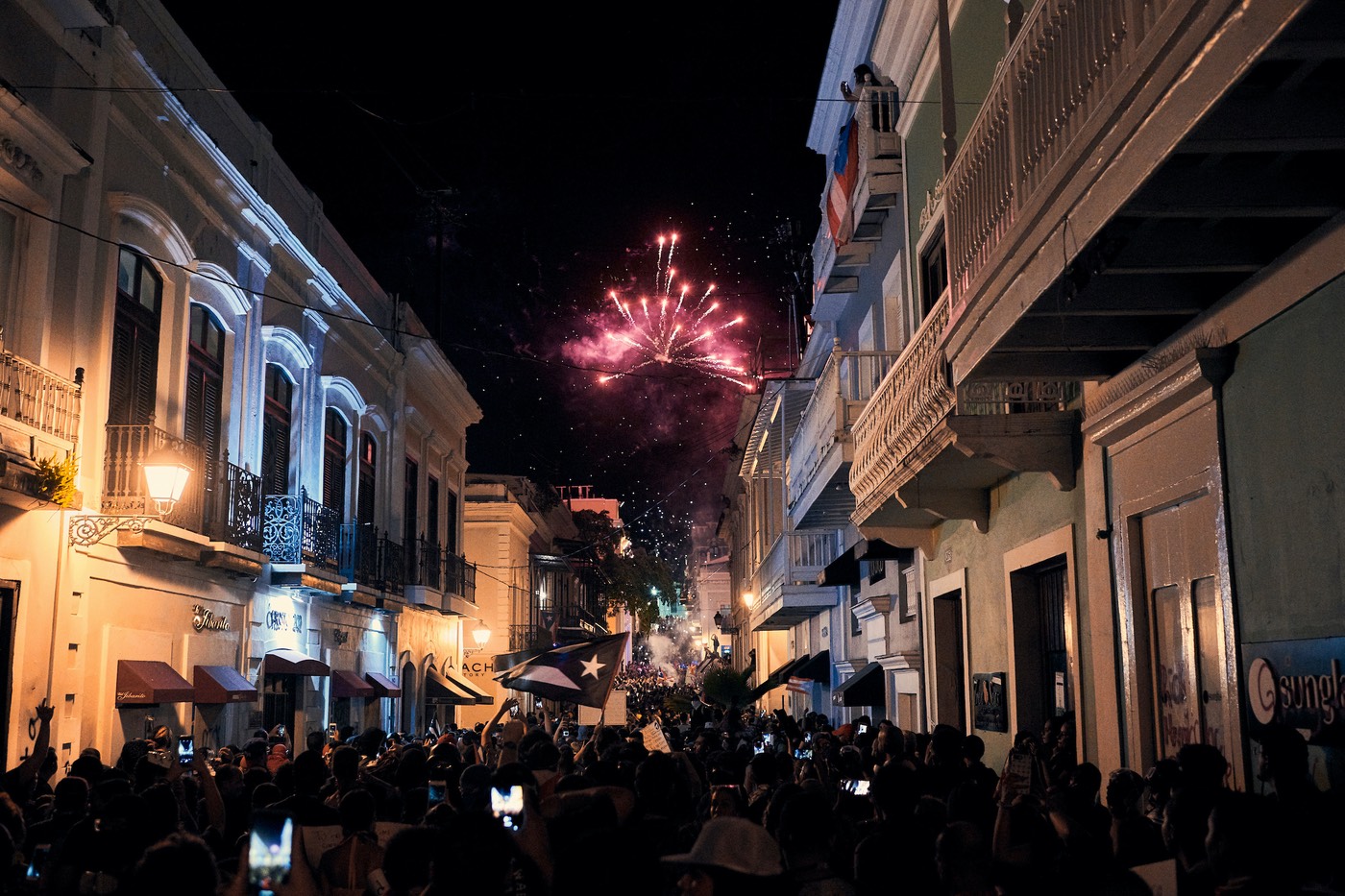
Pluma says CAM-JI is also firm in its stance against accepting federal funds. “We’re clear that to be decolonized, we need to make our own ways of decolonization, and that is not allying with the things that are not right.” Their projects to sustain the school are all based on agriculture: producing, selling, and exchanging food, and producing and selling organic fertilizer made from compost, for which there is a great need right now in Puerto Rico. Because the government is allied with agrochemical companies like Monsanto, these companies have deals in which the government gives their agrochemicals to farmers. She says there is now a common understanding among farmers in their region that agrochemicals are destructive to the earth, and that the only way is to go back to “our traditional ways of working the land.” She also believes that this network between four CAMs, as well as the larger network of CAMs across the island, will create an inside economy—one that doesn’t rely as much on resources from outside Puerto Rico, but exists between and sustains the CAMs and their surrounding communities. For example, she foresees that in the future CAM-JI will supply their organic fertilizers to CAM Carolinas for their garden, and perhaps CAM-JI will get bread from their bakery.
These collective experiences of mutual aid have provided Puerto Ricans with a greater resilience in the face of the crises of 2020, which include the magnitude-6.4 earthquake that struck the southwestern part of the island in January, followed by more than 1000 aftershocks that continued into May, as well as the COVID-19 pandemic. When the main earthquake hit in the early hours of January 7, destroying or damaging some 3000 homes in municipalities throughout the southwest and the central mountains and causing a widespread power outage, people already knew not to expect help from the state, and immediately organized their own grassroots relief efforts. “The government did not respond, just like with Maria,” says Pluma. Existing mutual aid groups, both from outside and within the affected areas, had been prepared by previous disasters and began to survey local residents to identify their needs and to collect and distribute needed items such as food, bottled water, and clothing. Due to the aftershocks, many residents slept outside for fear that their homes would collapse the next time the ground shook; this made it necessary to distribute supplies including tents, cots, air mattresses, and gas stoves. New mutual aid groups also formed in response to this crisis; many neighbors continue to support each other as new crises emerge.
Daniel explains that CAM Carolinas hasn’t been impacted harshly by the pandemic. He attributes this to people responding differently to COVID-19 in Puerto Rico than they have in the US. Almost everyone wears a mask, he says, and takes all the precautions recommended by the World Health Organization. At first, they suspended activities at the CAM and followed the news closely to learn how they should proceed. Once they understood that they could control the risks by using PPE and taking a variety of sanitary measures, they knew they didn’t have to stop the work. In the end, they were only closed for about a month. “Even though we are not first responders, we kind of are, in a way. Some of the services we are giving to the community are essential.”
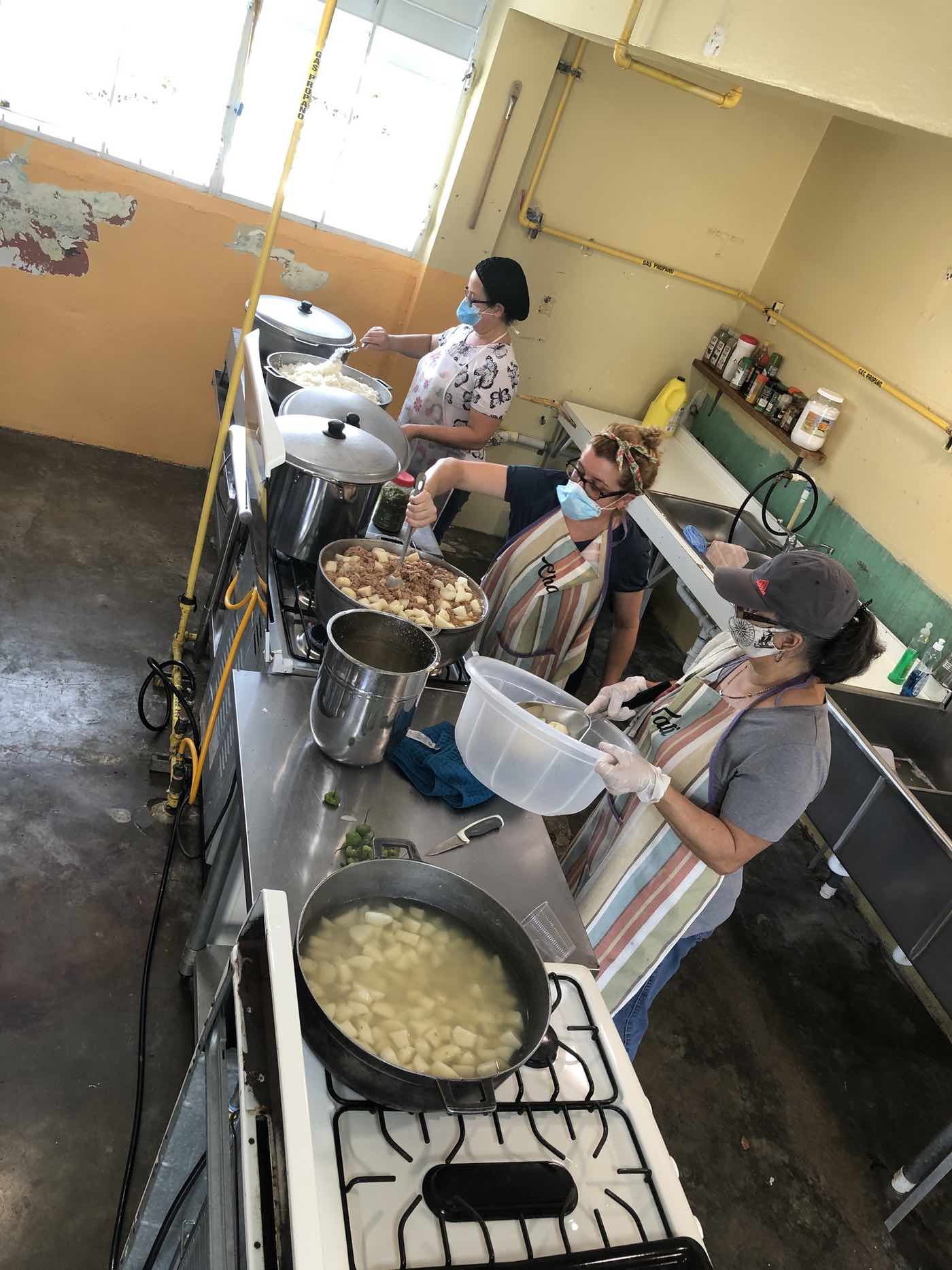
He recalls how when they reopened, 20 new young people arrived at the CAM, wanting to volunteer. More people wanted to help the community, he says, because they understood that the pandemic would mean more poverty and that the state and private sector would meet fewer essential needs. “The youth are looking for new political ways to manifest their anger. They want to contribute to their country in ways that are maybe different from what their parents have lived.”
“In Lares, we did stop work,” Pluma says of the early stage of the pandemic. “We were mostly doing reconstruction on the school, and stopped for a month or two, then started again.” They also saw an increase in volunteering, because people were concerned about how basic needs would be met once so many institutions had shut down. As people had come to expect, the government failed to respond to the crisis. While the authorities passed laws requiring people to wear masks, clean their hands, and stay in their homes at certain times, they didn’t supply residents with the PPE and other essential items that people required to accomplish those things. CAM-JI began to distribute PPE, held a workshop on making hand sanitizer for the community, and distributed food. “Only the community saves the community,” Pluma reiterates. “The government always gives their back to the community, even now.” During the two months that they stopped work, the CAM organized virtual conversations and conferences with the agricultural community. One conference focused on how they could respond to this issue as farmers; they held several conferences on Indigenous issues. Throughout all these conversations, they continually pointed out to people the “constant repetition of the government abandoning communities.”
While the participants in each CAM steadfastly assert that the schools belong to the community and the community stands behind them, occupying these buildings involves the constant risk of the state attempting to evict them. “In PR, things are kind of stuck right now,” says Pluma. At CAM-JI, they have submitted the legal documents required to “ask” for the school, according to the local government’s procedure. The agency that purports to own the building has yet to respond, however, because there’s a question as to which state agency the building actually belongs to. For the community, there’s no question regarding to whom it belongs; Pluma says they will continue to occupy it regardless of the outcome of the legal procedure. Their reconstruction of the building continues unabated, and they already have an event calendar. “We will defend it, no matter how,” she says. “The community is very concerned that no one is going to take our school from us. Those schools are ours.”
Not all public schools are “owned” by the Department of Education in Puerto Rico, making the question of who has the legal right to decide what to do with the buildings a vague one. For example, Daniel explains, the school in Las Carolinas is officially owned by the Administration of Roads and Highways, while some other schools are owned by municipalities. In the case of CAM Carolinas, he says, the agency hasn’t shown much interest in how the previously vacant school is used, though some companies have shown interest in purchasing the building for business purposes from time to time. Whenever these companies send someone to tell the women who coordinate the CAM that they are occupying the building illegally, the women simply reassert that the space is theirs and they have no intention of leaving. So far, companies have decided that they’d rather not pick a fight.
Lourdes emphasizes that the people are firm in their resolve not to be moved from the buildings that house their CAMs. “The communities involved in the project are solid,” she says. “No matter what pushback is coming in the near future or whenever, we are going to stay there. That has to be clear, so every time we are telling that to the people, that no matter who comes, be secure that this is yours.”
Daniel says he hasn’t seen any attempts at repression from local politicians lately, and posits that this is a result of the new political reality reflected in the 2020 local election. “This is a new Puerto Rico. Our collective mentality has changed in a more progressive way. So it’s going to be very, very, very difficult—if not suicidal, politically speaking—for any politician to try to take this project from the communities.” He dares to hope there’s a possibility that they could find some allies in this new political arena, and perhaps even gain the property titles to the schools.
While the results of the 2020 Puerto Rico election appear on the surface to reflect little shift from the status quo, several factors cast those results in a different light. Incumbent Governor Wanda Vázquez, who assumed office in August 2019 following Rosselló’s resignation, lost the New Progressive Party (PNP) nomination in the primaries to Pedro Pierluisi, who preceded her as governor from August 2 to 7 of that year. Rosselló had appointed Pierluisi secretary of state and declared him to be governor upon resigning, but his governorship was declared unconstitutional and nullified by the Puerto Rico Supreme Court because he hadn’t been confirmed by the Senate as secretary of state. On November 3, 2020, Pierluisi won the gubernatorial election with only 32.9% of the vote, the lowest percentage for any winning governor on the island to date. The PNP, of which Rosselló is also a member, advocates for Puerto Rico becoming the 51st of the United States; the party got a non-binding referendum added to the ballot in which 52% of voters came out in favor of statehood. The other of the two major political parties, the Popular Democratic Party (PPD), advocates retaining the current political status as an unincorporated territory of the US.
Yet this latest election indicated that the majority of voters are no longer interested in either of those options. Three other, smaller parties, including the Puerto Rican Independence Party, won nearly 35% of the vote altogether and gained six seats in the House of Representatives and Senate. Considering that only 53% of eligible voters participated in this election, it’s clear that the victories for statehood and the pro-statehood party don’t reflect the will of most Puerto Ricans, particularly the young generation who have grown up in a depressed economy and felt the full meaning of their colonial status in the federal government’s handling of Hurricane Maria and the earthquakes.
The referendum notwithstanding, Puerto Ricans remain disenfranchised for the foreseeable future, with no vote in the presidential election and no voting representative in US Congress. “In a colony,” says Daniel, “there is no democracy at all, because it is controlled by the imperial puppets.” He continues to be very skeptical of electoral politics as a path to independence, while noting what he describes as a “new spectrum” of radical leftism in the political arena. Daniel attributes this to the youth of Puerto Rico becoming more radical in their politics than preceding generations, and to people in general being “sick and tired” of corruption. “Some people are seeing, in the political arena, a way for us to express our anger,” he says. “But the importance of our projects is that we’re not only counting on the electoral arena. We’re creating structures of power for the working-class people in our own communities.”

Pluma has observed that one role of mutual aid in decolonization is to empower people by giving them space to develop the knowledge and talents they already have, where colonization had stifled that growth. “The interesting thing about us being a colony is that there are people who have so many things they want to do. They want to create, but the social and political conditions are not there. We facilitate a place of power, where people can find the tools to overcome that colonial context, that frontera colonial. Our economic development has been held hostage. Our social growth has been held hostage. So we are here to facilitate what is there; just to facilitate all this wisdom, all these abilities, all these tremendous projects and things that our people want to do. But there’s a frontier there, a frontier of colonization that tries to stop us.”
Daniel theorizes that this type of work resonates more with people right now because of the political vacuum that exists. “The people do not relate to the state,” he says. “We, as the people, don’t have a relationship with the state because it’s not there. It’s like a phantom.” For this reason, he believes their strategy of “creating spaces for people to self-organize and to see themselves as the key elements towards our survival as a community” can lead to the autonomy they seek. “We are basically creating the country that we want. We are creating the structures for this new state, bottom-up.”
“We are definitely on the road to decolonization, in all terms—political, economic, social,” says Pluma. “We are here, and we’re not going to stop.”


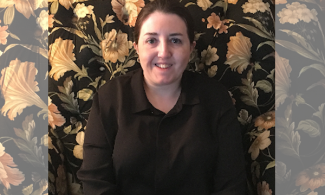
Add new comment